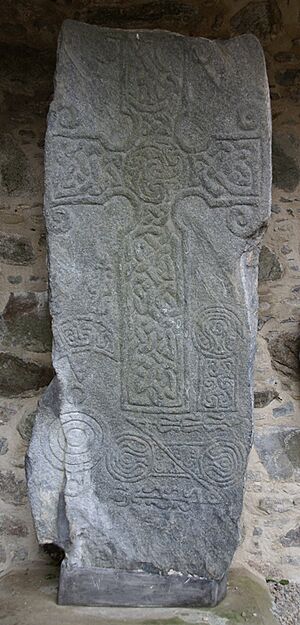Dyce stones facts for kids
Quick facts for kids Dyce stones |
|
|---|---|

Dyce II
|
|
| Symbols | Dyce I: Pictish Beast; Double disc and z-rod Dyce II: Knotwork interlaced cross; Crescent and v-rod; triple disc; double disc and z-rod; mirror case |
| Created | Sixth-Ninth Century CE |
| Place | Dyce, Aberdeen, Scotland |
| Coordinates | 57°13′45″N 2°12′30″W / 57.2293°N 2.2082°W |
| Classification | Dyce I: Type I incised stone Dyce II: Type II cross slab |
| Culture | Picto-Scottish |
The Dyce stones are ancient carved stones found in Dyce, a town near Aberdeen, Scotland. These stones were made by the Picts, an ancient people who lived in Scotland a long time ago. They are now kept safe in a special shelter at the old St Fergus's Chapel.
There are two main stones, called Dyce I and Dyce II. These stones have special symbols carved into them that tell us about the Picts. There are also a few smaller carved stones in the collection.
What Are the Dyce Stones?
The Dyce stones are important pieces of history. They show us the art and symbols used by the Picts between the 6th and 9th centuries CE. These stones help us learn about their beliefs and culture.
Dyce I: The Carved Stone
Dyce I is a type of stone called a Class I Pictish stone. This means the symbols are carved into the stone, like a drawing etched onto the surface.
The symbols on Dyce I are:
- The Pictish Beast: This is a mysterious animal that looks a bit like a sea monster or elephant.
- The Double disc and z-rod: This symbol looks like two circles connected by a zig-zag line.
Dyce II: The Cross Slab
Dyce II is a Class II Pictish stone, also known as a cross slab. This means it has a Christian cross carved on one side, along with Pictish symbols. The cross is a Celtic cross, which is a special type of cross with a circle around the middle. It's decorated with fancy knotwork, which are patterns that look like woven ropes. In the center of the cross, there's a raised part called a boss with swirly designs.
Around the bottom of the cross, you can see more Pictish symbols:
- The Crescent and v-rod: This looks like a moon shape with a V-shaped rod.
- Double disc and z-rod: Similar to the one on Dyce I.
- Triple disc: Three circles.
- Mirror case: A symbol that looks like an old mirror case.
On the side of Dyce II, there's also an Ogham inscription. Ogham is an ancient alphabet that uses lines and notches. The inscription on Dyce II spells out:
- EOTTASSARRHETODDEDDOTS MAQQ ROGODDADD
Gallery


